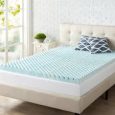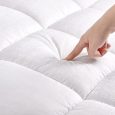If you’re tired of waking up with an achy back, it may be time to consider a high-density foam mattress topper. With its ability to provide exceptional support and cushioning, a foam topper can alleviate pressure points and promote proper spinal alignment. Say goodbye to tossing and turning all night, and hello to waking up feeling refreshed and pain-free. Discover how incorporating a high-density foam mattress topper into your sleep routine can transform your nights and improve your overall well-being.
Benefits of High-Density Foam Mattress Toppers
Improved Spinal Alignment
One of the key benefits of using a high-density foam mattress topper is improved spinal alignment. When your spine is properly aligned during sleep, the pressure on your back is greatly reduced. High-density foam adapt and conform to the shape of your body, providing optimal support to your spine and ensuring that it maintains its naturally curved shape. This can help alleviate back pain caused by improper spinal alignment and promote a healthier sleep posture. By enhancing spinal alignment, high-density foam mattress toppers can contribute to long-term back pain relief.
Pressure Point Relief
Another advantage of high-density foam mattress toppers is their ability to provide pressure point relief. As you sleep, certain areas of your body such as the shoulders, hips, and lower back may experience increased pressure due to the weight distribution. High-density foam has a unique ability to distribute body weight evenly, reducing the pressure on these sensitive areas. This even distribution helps to alleviate discomfort, promote better circulation, and prevent the development of pressure sores. By relieving pressure points, high-density foam mattress toppers can effectively reduce back pain and improve overall comfort during sleep.
Enhanced Comfort and Support
Lastly, high-density foam mattress toppers offer enhanced comfort and support. The dense structure of the foam provides a solid base that helps to alleviate any sagging or sinking that may occur with an older or worn-out mattress. This extra layer of support can contour to your body, providing a comfortable sleeping surface that cradles your body and reduces stress on your back. Additionally, high-density foam is known for its motion isolation properties, meaning that it can absorb the movement caused by tossing and turning, allowing for a more restful sleep. By providing both comfort and support, high-density foam mattress toppers can greatly improve your sleep quality and help alleviate back pain.
Types of High-Density Foam Mattress Toppers
Memory Foam Toppers
Memory foam mattress toppers are one of the most popular options when it comes to high-density foam. This type of foam is known for its ability to contour to your body shape, providing personalized comfort and support. Memory foam reacts to body heat, allowing it to mold to your unique curves for a customized sleeping experience. It helps relieve pressure points and promotes proper spinal alignment, making it an excellent choice for individuals with back pain. Memory foam mattress toppers come in various thicknesses and densities, allowing you to choose the one that best suits your needs.
Latex Foam Toppers
Latex foam mattress toppers are another option to consider when looking for high-density foam for back pain relief. Latex foam is naturally responsive and provides excellent support to the body. It has a bit more bounce compared to memory foam, making it preferred by individuals who want a more responsive sleeping surface. Latex foam is also known for its durability and breathability, allowing for a cooler sleep experience. Additionally, latex foam is hypoallergenic and resistant to dust mites, making it an excellent choice for those with allergies or asthma.
Gel-Infused Foam Toppers
Gel-infused foam mattress toppers combine the benefits of high-density foam with the cooling properties of gel. The gel infusion helps to regulate temperature and dissipate heat, keeping you cool and comfortable throughout the night. Gel-infused foam also provides similar pressure-relieving benefits as memory foam and latex foam, helping to alleviate back pain. If you tend to sleep hot or live in a warm climate, a gel-infused foam mattress topper can be an ideal choice for you.
Choosing the Right Thickness and Density
When selecting a high-density foam mattress topper for back pain relief, it’s essential to consider the thickness and density that best suits your needs. Here are some factors to keep in mind:
Consider Your Weight and Sleeping Position
Your weight and sleeping position play a crucial role in determining the appropriate thickness and density for your foam mattress topper. If you are on the heavier side, you may need a thicker and denser topper to provide sufficient support and prevent sinking. Similarly, side sleepers may benefit from a thicker topper to cushion the hips and shoulders, while back and stomach sleepers may prefer a thinner topper for more firm support. Assess your weight and preferred sleeping position to make an informed decision.
Assess Your Current Mattress
Take into account the condition of your current mattress when choosing the thickness and density of your foam topper. If your mattress is already quite firm, a thinner topper may be sufficient to add a layer of comfort. However, if your mattress is sagging or lacks support, a thicker and denser topper can help compensate for its shortcomings. Assessing your current mattress will help you determine the right thickness and density to achieve the desired level of comfort and support.
Trial Periods and Warranty
Lastly, when purchasing a high-density foam mattress topper, it’s wise to consider any available trial periods or warranties. Some manufacturers offer trial periods of a specific duration, allowing you to test the topper and determine if it improves your back pain. Additionally, warranties can protect you against any manufacturing defects or premature wear. Be sure to review these details before making your purchase to ensure peace of mind.
Proper Placement and Maintenance
Once you have chosen the right high-density foam mattress topper for your needs, it’s important to follow proper placement and maintenance procedures to maximize its benefits and longevity.
Ensuring Proper Alignment with the Mattress
To achieve optimal support and alignment, it’s crucial to ensure that your foam topper is properly aligned with your mattress. Place the topper directly on top of your mattress, making sure it covers the entire surface evenly. This will prevent any uneven pressure points and allow the topper to contour to your body properly. Regularly inspect the placement to ensure it hasn’t shifted, as this can affect its performance.
Regular Cleaning and Care
High-density foam mattress toppers require regular cleaning and care to maintain their quality. Remove and wash any removable covers according to the manufacturer’s instructions. For the foam itself, spot clean any spills or stains using a mild detergent and water. Avoid using harsh chemicals or excessive water, as this can damage the foam. Allow the foam topper to completely air dry before placing it back on the bed. Regular cleaning and care will help prolong the lifespan of your foam topper and ensure optimal hygiene.
Rotating and Flipping
Another maintenance tip is to periodically rotate and flip your high-density foam mattress topper. This helps distribute the wear and pressure evenly across the topper, preventing excessive wear in one area. By rotating and flipping the topper, you can extend its lifespan and maintain consistent support and comfort levels. Refer to the manufacturer’s instructions for guidance on the frequency of rotation and flipping.
Additional Back Pain Relief Techniques
While high-density foam mattress toppers can provide significant relief for back pain, incorporating additional techniques into your routine can further enhance the benefits. Here are a few suggestions:
Practicing Good Sleep Posture
Maintaining good sleep posture is essential for minimizing back pain. Use supportive pillows to align your head, neck, and spine in a neutral position. Avoid sleeping on your stomach, as this can strain the back and neck. Instead, try sleeping on your side with a pillow between your knees or on your back with a pillow under your knees for added support. By practicing good sleep posture, you can reduce the risk of developing or exacerbating back pain.
Regular Stretching and Exercise
Engaging in regular stretching and exercise can help strengthen the muscles in your back and alleviate pain. Focus on exercises that target the core muscles, such as planks, bridges, and pelvic tilts. Additionally, incorporating gentle stretching into your daily routine can help improve flexibility and relieve tension in the back. Consult with a healthcare professional or physical therapist to determine the most suitable exercises for your specific needs.
Using Heat or Cold Therapy
Heat and cold therapy can provide temporary relief for back pain. Apply a heating pad or take a warm bath to relax the muscles and increase blood flow to the affected area. Alternatively, using an ice pack or a cold compress can help reduce inflammation and numb the area, providing pain relief. Experiment with both heat and cold therapy to determine which method works best for you.
Frequently Asked Questions
Can a foam mattress topper help with back pain?
Yes, a high-density foam mattress topper can help alleviate back pain by improving spinal alignment, relieving pressure points, and providing enhanced comfort and support.
How long does it take for a foam mattress topper to relieve back pain?
The duration of relief varies from person to person. Some individuals may experience immediate relief, while others may take a few days or weeks to notice significant improvement in their back pain. It’s important to allow sufficient time for your body to adjust to the new sleeping surface.
Can a foam mattress topper worsen back pain?
If the foam topper does not provide appropriate support or is of insufficient quality, it can potentially worsen back pain. This is why it’s crucial to select a high-density foam mattress topper that suits your specific needs and preferences.
Conclusion
Investing in a high-density foam mattress topper can be a game-changer for individuals seeking relief from back pain. The improved spinal alignment, pressure point relief, and enhanced comfort and support offered by high-density foam can alleviate discomfort, promote better sleep, and improve overall well-being. By choosing the right thickness and density, ensuring proper placement and maintenance, and incorporating additional back pain relief techniques, you can optimize the benefits of a high-density foam mattress topper and achieve a restful and pain-free sleep experience.



